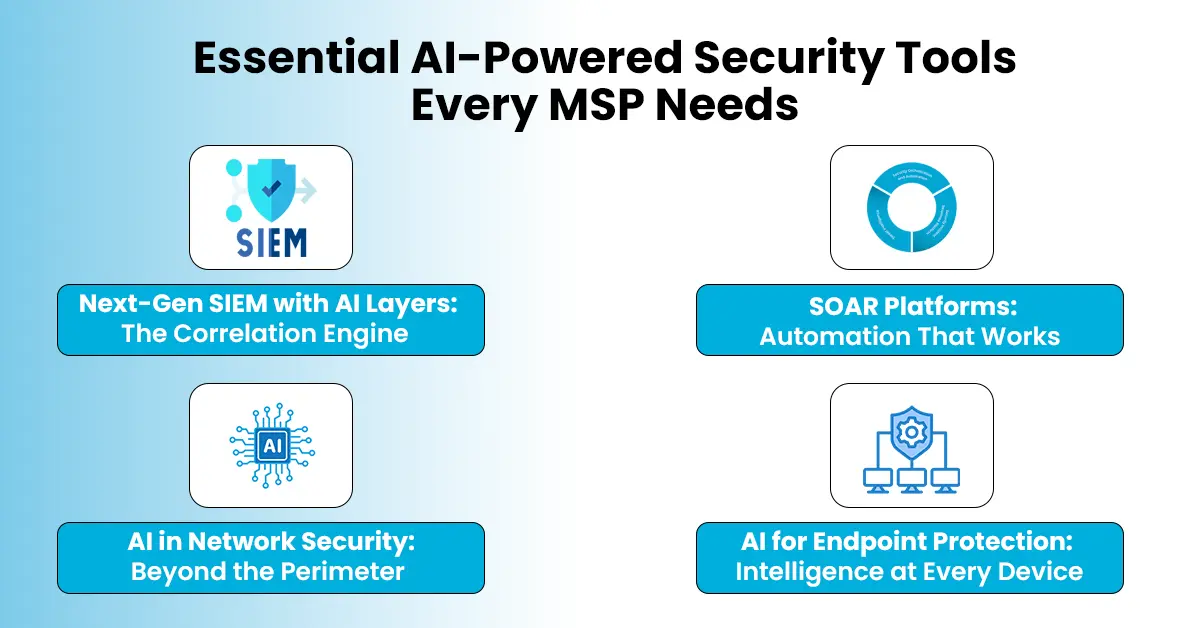If you’re running an MSP today, you’ve likely noticed your security analysts looking increasingly haggard—dark circles under their eyes and that thousand-yard stare that screams “if I see one more false positive alert, I might snap.”
You’re not alone. Welcome to modern cybersecurity operations, where the average SOC analyst drowns in alerts while genuine threats slip through undetected. But there’s hope, and it comes in the form of AI in cybersecurity.
The Modern MSP Security Dilemma: Drowning in a Sea of Alerts
According to IBM’s 2023 “Cost of a Data Breach” report, organizations using security AI and automation experienced breach costs that were, on average, $3.05 million lower than organizations without these technologies. The same study revealed that security teams without AI support faced an average of 17,400 security alerts per week, with false positive rates exceeding 80% in many environments.
AI in cybersecurity isn’t just another tech buzzword—it’s becoming the life preserver keeping your security analysts from drowning. By implementing AI for threat detection, MSPs are seeing dramatic reductions in false positives while simultaneously improving detection rates for genuine threats.
The Cost of Alert Overload
- 76% of cybersecurity professionals report symptoms of burnout
- Average analyst turnover rates exceed 30% annually
- 68% admit to “alert apathy”—ignoring certain categories of alerts altogether
When your team experiences burnout, everyone loses—your analysts, your MSP, and most importantly, your clients. This is where AI in cybersecurity creates its most immediate value: keeping your human experts human.
The Evolution of AI in Cybersecurity: From Rules to Intelligence
Remember when cybersecurity was all about signature-based detection and static rules? Those days seem quaint now.
The way we approach security operations has fundamentally changed with the advent of the contemporary AI-powered SOC. These sophisticated systems use machine learning to create behavioral baselines, spot abnormalities, and instantly adjust to new threats rather than depending just on preset rules.
After using AI for threat detection, MSPs who use AI-powered SOC solutions claim 74% fewer false positives and mean time to detect (MTTD) improvements of 63% on average.
Breaking the Alert Fatigue Cycle with AI-Driven Analysis
Not only is alert tiredness irritating, but it’s also harmful. When your analysts lose their sensitivity to alarms, real risks are overlooked. It’s the equivalent of the “boy who cried wolf” in cybersecurity.
AI in cybersecurity disrupts this damaging loop by radically altering the creation, prioritization, and processing of warnings.
AI for Threat Detection: Beyond Signature-Based Approaches
Traditional security tools rely heavily on known threat signatures—essentially looking for exact matches of previously identified malicious code or behavior. Modern AI for threat detection takes a dramatically different approach:
- Machine learning models establish “normal” behavioral baselines
- Deviations from these baselines trigger investigation
- Pattern recognition identifies threat actor techniques, not just tools
- Continuous learning improves accuracy over time
The result? AI for threat detection systems catch what traditional tools miss while dramatically reducing false positives.
AI-Based Anomaly Detection: Finding Needles in Digital Haystacks
The capacity of AI in cybersecurity to recognize the unknown is arguably its most remarkable feature. AI-based anomaly detection systems are able to identify minute signs of intrusion that would never cause rule-based warnings by using unsupervised learning techniques.
For example, when an administrator account suddenly begins accessing unusual database tables at 3 AM from an unrecognized location, AI-based anomaly detection recognizes the behavioral deviation even if every individual action appears legitimate when viewed in isolation.
Essential AI-Powered Security Tools Every MSP Needs
Let’s get practical. What specific tools should you be evaluating to transform your security operations with AI in cybersecurity?

Next-Gen SIEM with AI Layers: The Correlation Engine
Traditional Security Information and Event Management (SIEMs) were essentially glorified log collection systems. Today’s AI-powered SOC platforms use machine learning to identify relationships between events that human analysts would never discover on their own.
Modern SIEM platforms with AI in cybersecurity capabilities offer:
- Automated threat hunting across your entire environment
- Risk-based alerting that prioritizes high-impact threats
- Dynamic threshold adjustments based on environmental context
- Multi-dimensional correlation beyond simple rule matching
SOAR Platforms: Automation That Works
When paired with AI for threat detection, Security Orchestration, Automation and Response (SOAR) platforms become the execution arm of your AI-powered SOC. These systems don’t just identify threats—they respond to them automatically according to predefined playbooks.
The combination of AI in cybersecurity for detection and SOAR for response creates a multiplier effect, allowing your team to handle exponentially more security events without increasing headcount.
AI in Network Security: Beyond the Perimeter
Network defense has evolved far beyond basic firewalls. Today’s AI in network security solutions offer:
- Real-time traffic analysis identifying command-and-control communications
- Automatic recognition of data exfiltration attempts
- Dynamic network segmentation in response to threats
- Behavioral baselining of normal network patterns
By implementing AI in network security, MSPs can provide their clients with adaptive defense that responds to emerging threats without constant manual reconfiguration.
AI for Endpoint Protection: Intelligence at Every Device
Endpoints remain among the most vulnerable attack surfaces, but AI for endpoint protection has transformed how we secure these devices:
- Behavioral monitoring instead of signature matching
- Pre-execution analysis of suspicious code
- Automatic containment of potentially compromised devices
- Continuous validation of device security posture
Modern AI for endpoint protection solutions don’t just detect malware—they prevent its execution entirely by recognizing malicious behavior patterns before damage occurs.
Implementing AI-Driven Threat Management: A Quick-Start Guide
Ready to transform your security operations with AI in cybersecurity? Start with these key steps:
- Assess Your Current Stack: Evaluate your existing tools for AI in cybersecurity integration potential
- Prioritize Integration: Choose AI-powered SOC solutions with robust APIs and unified data models
- Invest in Skills: Train your team to interpret and validate outputs from AI for threat detection systems
Remember that AI in cybersecurity augments human analysts—it doesn’t replace them. Your team needs to evolve from alert processors to AI supervisors and investigators.
Building Client Trust Through Your AI Security Advantage
Your clients don’t care about the technical details of AI in cybersecurity—they care about outcomes. When communicating your enhanced capabilities, focus on:
- Faster threat detection and response times
- More comprehensive protection against emerging threats
- Reduced business disruption from security events
- Higher confidence in security posture assessments
By translating your AI-powered SOC advantages into business benefits, you create compelling reasons for clients to choose—and stick with—your MSP.
Build IT LIVE 2025: Your AI Cybersecurity Transformation Hub
Still feeling overwhelmed by the rapidly evolving world of AI in cybersecurity? You’re not alone—and there’s a place where you can find answers to all your questions.
Build IT LIVE 2025 brings together the brightest minds in AI-powered SOC implementation specifically for MSPs. This premier event features:
- Expert-led sessions on AI for threat detection implementation
- Live demonstrations showing AI in network security reducing false positives by 80%+
- Hands-on workshops with leading AI-based anomaly detection platforms
- Exclusive networking with MSPs who’ve mastered AI like Ryan Bowman for endpoint protection
Ready to Transform Your Security Operations?
Don’t let your team drown in alerts while real threats slip through. At Build IT LIVE 2025, you’ll connect with industry pioneers who’ve conquered alert fatigue and transformed their security operations through AI in cybersecurity.
What you’ll gain:
- Ready-to-implement AI-powered SOC frameworks tailored for MSPs
- Direct access to solution providers offering MSP-specific AI for endpoint protection tools
- A concrete roadmap to reduce false positives by at least 60%
- Strategies to position your enhanced AI in network security capabilities to clients
- Exclusive insights from Ryan Bowman, a prominent MSP industry leader who pioneered AI in cybersecurity implementations that have revolutionized threat detection for service providers.
Register Now for Build IT LIVE 2025 – Where AI Meets Cybersecurity Excellence






